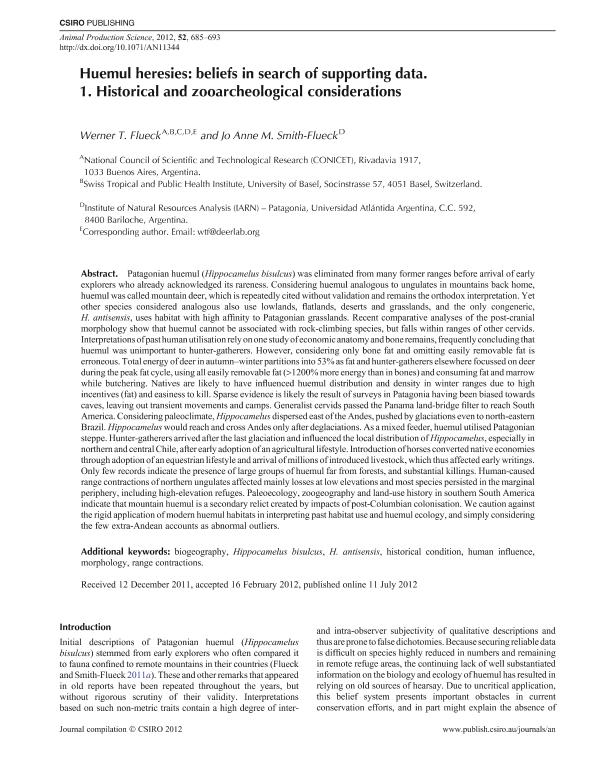Mostrar el registro sencillo del ítem
dc.contributor.author
Fluck, Werner Thomas

dc.contributor.author
Smith-Flueck, Jo Anne M.
dc.date.available
2023-05-22T14:08:08Z
dc.date.issued
2012-07
dc.identifier.citation
Fluck, Werner Thomas; Smith-Flueck, Jo Anne M.; Huemul heresies: Beliefs in search of supporting data. 1. Historical and zooarcheological considerations; Csiro Publishing; Animal Production Science; 52; 8; 7-2012; 685-693
dc.identifier.issn
1836-5787
dc.identifier.uri
http://hdl.handle.net/11336/198357
dc.description.abstract
Patagonian huemul (Hippocamelus bisulcus) was eliminated from many former ranges before arrival of early explorers who already acknowledged its rareness. Considering huemul analogous to ungulates in mountains back home, huemul was called mountain deer, which is repeatedly cited without validation and remains the orthodox interpretation. Yet other species considered analogous also use lowlands, flatlands, deserts and grasslands, and the only congeneric, H. antisensis, uses habitat with high affinity to Patagonian grasslands. Recent comparative analyses of the post-cranial morphology show that huemul cannot be associated with rock-climbing species, but falls within ranges of other cervids. Interpretations of past human utilisation rely on one study of economic anatomy and bone remains, frequently concluding that huemul was unimportant to hunter-gatherers. However, considering only bone fat and omitting easily removable fat is erroneous. Total energy of deer in autumnwinter partitions into 53% as fat and hunter-gatherers elsewhere focussed on deer during the peak fat cycle, using all easily removable fat (1200% more energy than in bones) and consuming fat and marrow while butchering. Natives are likely to have influenced huemul distribution and density in winter ranges due to high incentives (fat) and easiness to kill. Sparse evidence is likely the result of surveys in Patagonia having been biased towards caves, leaving out transient movements and camps. Generalist cervids passed the Panama land-bridge filter to reach South America. Considering paleoclimate, Hippocamelus dispersed east of the Andes, pushed by glaciations even to north-eastern Brazil. Hippocamelus would reach and cross Andes only after deglaciations. As a mixed feeder, huemul utilised Patagonian steppe. Hunter-gatherers arrived after the last glaciation and influenced the local distribution of Hippocamelus, especially in northern and central Chile, after early adoption of an agricultural lifestyle. Introduction of horses converted native economies through adoption of an equestrian lifestyle and arrival of millions of introduced livestock, which thus affected early writings. Only few records indicate the presence of large groups of huemul far from forests, and substantial killings. Human-caused range contractions of northern ungulates affected mainly losses at low elevations and most species persisted in the marginal periphery, including high-elevation refuges. Paleoecology, zoogeography and land-use history in southern South America indicate that mountain huemul is a secondary relict created by impacts of post-Columbian colonisation. We caution against the rigid application of modern huemul habitats in interpreting past habitat use and huemul ecology, and simply considering the few extra-Andean accounts as abnormal outliers.
dc.format
application/pdf
dc.language.iso
eng
dc.publisher
Csiro Publishing

dc.rights
info:eu-repo/semantics/openAccess
dc.rights.uri
https://creativecommons.org/licenses/by-nc-sa/2.5/ar/
dc.subject
BIOGEOGRAPHY
dc.subject
H. ANTISENSIS
dc.subject
HIPPOCAMELUS BISULCUS
dc.subject
HISTORICAL CONDITION
dc.subject
HUMAN INFLUENCE
dc.subject
MORPHOLOGY
dc.subject
RANGE CONTRACTIONS.
dc.subject.classification
Conservación de la Biodiversidad

dc.subject.classification
Ciencias Biológicas

dc.subject.classification
CIENCIAS NATURALES Y EXACTAS

dc.title
Huemul heresies: Beliefs in search of supporting data. 1. Historical and zooarcheological considerations
dc.type
info:eu-repo/semantics/article
dc.type
info:ar-repo/semantics/artículo
dc.type
info:eu-repo/semantics/publishedVersion
dc.date.updated
2023-05-08T13:23:31Z
dc.journal.volume
52
dc.journal.number
8
dc.journal.pagination
685-693
dc.journal.pais
Australia

dc.journal.ciudad
Collingwood
dc.description.fil
Fil: Fluck, Werner Thomas. Consejo Nacional de Investigaciones Científicas y Técnicas. Centro Científico Tecnológico Conicet - Mar del Plata; Argentina. Universidad de Basilea; Suiza. Universidad Atlantida Argentina; Argentina. Fundación Bariloche; Argentina
dc.description.fil
Fil: Smith-Flueck, Jo Anne M.. Universidad Atlantida Argentina; Argentina
dc.journal.title
Animal Production Science

dc.relation.alternativeid
info:eu-repo/semantics/altIdentifier/url/https://www.publish.csiro.au/?paper=AN11344
dc.relation.alternativeid
info:eu-repo/semantics/altIdentifier/doi/http://dx.doi.org/10.1071/AN11344
Archivos asociados
